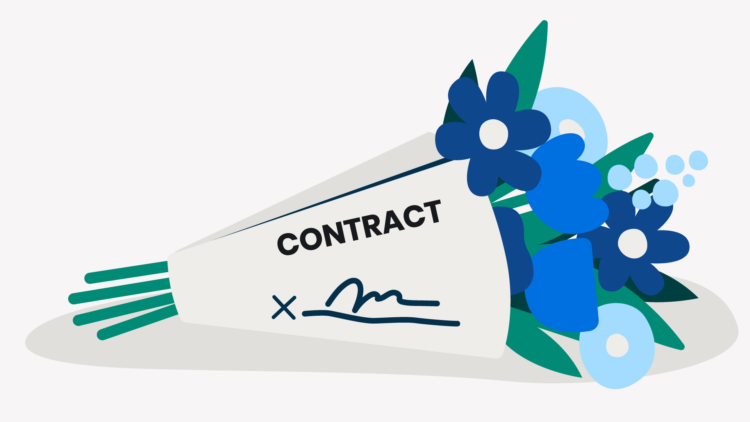The client onboarding process is an important part of your relationship with any client.
It’s where you make your first impression and start building their trust. It’s where you assess the merits of their legal matter and come up with potential courses of action. And most importantly, at least from a business standpoint, it’s where you convert a prospect into a paying customer (i.e. it’s your sales process).
In this post, we share 10 tips to improve client onboarding at your law firm to help you build stronger relationships with clients, make your operations more efficient, and grow your practice.
1. Break the client onboarding process into well-defined stages
Without a well-structured onboarding process, it’s difficult to stay on top of everything. How do you know who has upcoming appointments, who has pending retainers, or who needs to be followed up with, for example?
Disorganisation can lead to unnecessary delays in the process. It can also lead to potential clients slipping through the cracks, meaning lost business for your firm. Breaking your onboarding process into well-defined stages is the best way to avoid these problems.
Whether you use an Excel sheet or a case management system like Clio to manage your potential clients, think about defining different stages of the onboarding process and tracking each prospect by stage. For example, you might want to classify your prospects as one of the following:
- “Not Yet Contacted”
- “Needs Follow Up”
- “Intake Form Pending”
- “Retainer Pending”
- “Awaiting Payment”
This will give you a much clearer picture of which clients (or potential clients) need your immediate attention, and where the potential bottlenecks may lie.
2. Always send appointment reminders
Let’s face it—appointments get missed, and they get missed more often by prospective clients who don’t have a strong relationship with you yet. These things happen. But, when a client flakes on an appointment over and over, it causes unnecessary frustration and takes valuable time out of your working day.
To avoid this frustration, send a reminder via email or text before every appointment, or call the person you’re meeting with directly to confirm. It may seem like an added burden, but it’s well worth the effort because reminders can drastically reduce the likelihood of cancelled appointments or no-shows.
If you really want to streamline things, you can use appointment scheduling software to generate these reminders automatically. For example, Clio Grow has a built-in scheduling tool that can add the appointment to your Clio, Outlook, or Google calendar. Clio Grow then generates an automated appointment reminder for your clients.
You may like these posts
3. Use checklists to stay organised
With so many tasks to complete each day and so many deadlines to keep track of, managing a law practice can seem overwhelming. The keys to long-term success are to stay organised and to implement well-defined processes early on.
Using client onboarding checklists is one of the best ways to create structured processes for your firm. They will help you ensure that all the important information is collected, no steps are overlooked, and no deadlines are missed.
Not only will this make your operations more efficient, but you will also reduce the likelihood of costly mistakes that could give rise to a malpractice claim. Most importantly, having organised processes will give you the foundation needed to hire more staff and scale up your operations as you grow.
4. Reduce or eliminate data entry by using online forms
Client onboarding requires gathering a lot of data. If your law firm is like most, you end up having to manually enter this data into a case management system or other database.
Data entry is repetitive, time-consuming, and can be prone to errors, exposing you to unnecessary risks of malpractice. By eliminating data entry or reducing it to a minimum, you will not only reduce errors, but you’ll also save hours of time and money in the process.
You can greatly reduce the burden of data entry by using online intake forms instead of paper or PDF ones. Online forms can be linked directly to Clio with Clio’s online intake software. Clients fill out their information online, and then you can push the data into your case management system with just a couple of clicks.
5. Automate the drafting of engagement agreements
Drafting an engagement agreement is a mandatory step in the client onboarding process. However, because the drafting process occurs pre-retention when you can’t bill for hours worked, it tends to be done hastily with minimal time spent on revisions. Naturally, this haste can result in a higher incidence of mistakes.
These errors are problematic for obvious reasons—whether they are just typos that make you look unprofessional or major oversights that expose you to unnecessary liability. Either way, it’s best to eliminate error-prone processes from your workflow as soon as possible.
With document automation software, you can create standardised templates to encompass a variety of different situations and matter types, and then use software to auto-populate the appropriate data into these templates. Automation will help keep mistakes and oversights to a bare minimum, and save you a lot of time.
6. Offer e-signatures to streamline the retention process
Before he or she starts working with you, a potential client must open an email, download a PDF, print it out, sign it, scan it, and email it back. That’s a lot of steps, and many things could go wrong along the way.
Don’t let a printer without ink be the reason you don’t get hired!
When it comes to bringing on new clients, your goal should always be to keep the number of barriers (or excuses) standing in the way to an absolute minimum. One of the best ways to streamline your onboarding process is to offer e-signatures on fee agreements and other documents.
For example, Clio Grow’s e-signature feature allows you to automate a document, insert it into an email, and send it out for e-signing in a matter of seconds. The client can then sign your documents digitally from any device without having to download, print, or scan them. This can save hours of your valuable time, and most importantly, it can help eliminate what is otherwise a potential bottleneck to being hired.
7. Use drip emails to educate and engage your prospective clients
Depending on your practice area, your clients may be dealing with scary or difficult situations when they start looking for representation. It can be intimidating for them to pull the trigger and hand over their money to hire a lawyer. Naturally, the more you can do to ease their concerns, the more likely it is that your potential clients will become paying clients.
One way to address your potential client’s concerns is through drip email marketing. You can use templates from Clio Grow to send a series of automated emails out at predefined time intervals, to keep a prospect engaged and interested.
For example, you could send out a series of FAQs relevant to their legal matter, educational material to help them understand the risks they face and the benefits of hiring a lawyer, or simply a short message to check in and see if they’re ready to move forward. Keeping your potential clients engaged by educating them about the situation they face will help build trust, increasing the likelihood of them retaining you.
Learn more about how Clio Grow helps you market your firm.
8. Track the source of every potential client
The key to growing any business, including a law practice, often comes down to finding the right marketing channels. In other words, where can you consistently advertise to acquire customers? More importantly, where can you do this for less money than each customer pays you on average?
Identifying the right channels will require some testing and trial and error. Throughout the process, you must track the source of every potential client you encounter. Otherwise, it’s nearly impossible to make an informed decision about which channels are working best.
Get in the habit of asking how new clients learned about your firm, and track their responses in a database. You should analyse the data regularly to get a clear picture of which marketing efforts are yielding the best results.
9. Track new clients to calculate your conversion rate
How will you know if any of your improvement efforts are working if you don’t have a quantitative way to measure the results? Key performance indicators (KPIs) are designed for this exact purpose.
One of the most important KPIs for a law firm to measure is its conversion rate. In other words, what percentage of prospective clients end up hiring your firm? Track your conversion rate, right alongside where you track the source of your potential clients.
There may be good reasons for a prospect not to hire you (e.g., they may not be a good fit, or they may not be able to afford your services), so your conversion rate is not a be-all, end-all measurement of how well you’re doing at marketing and client onboarding. Still, by establishing a baseline conversion rate for a given period of time and continuing to measure it on an ongoing basis, you will start to see some trends emerge, giving you an unbiased view of how you’re doing. Ideally, you should be working to maximise your conversion rate and see an upward trend over time.
10. Use all of these points to create a consistent, repeatable client onboarding process
Ultimately, building a successful law practice largely comes down to your operations. If you have strong systems in place to maximise efficiency and eliminate bottlenecks from your workflows, you will be able to steadily increase your caseload and expand your staff. It’s a matter of building a solid foundation from the start to set yourself up for success.
The onboarding process is a particularly important area to optimise because it falls outside the scope of the client’s representation, meaning you aren’t paid for the time you spend. By streamlining this process and making it organised and repeatable, you will reduce wasted time, provide an easier experience for clients, and increase your conversion rate.
In short, invest some time in improving your client onboarding process, and your practice will be that much better positioned to grow and thrive.
Looking for even more tips to dazzle clients with your law firm intake process? Read our post on how to win clients with a seamless law firm onboarding process.
We published this blog post in January 2024. Last updated: .
Categorized in: Business
Explore AI insights in our latest report
Our latest Legal Trends Report explores the shifting attitudes toward AI in the legal profession and the opportunities it brings for law firm billing, marketing, and more.
Read the report





